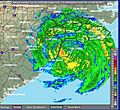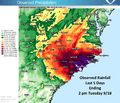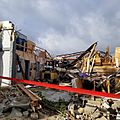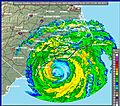Hurricane Florence (2018) facts for kids
| Category 4 major hurricane (SSHWS/NWS) | |
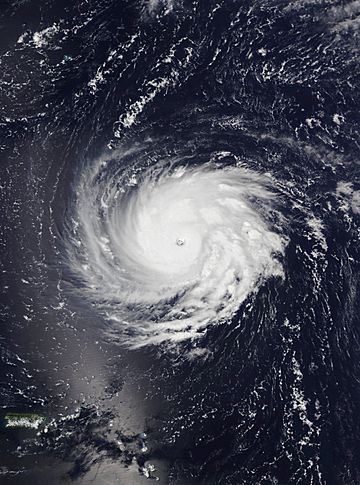
Hurricane Florence near peak intensity southeast of Bermuda on September 10
|
|
| Formed | August 31, 2018 |
|---|---|
| Dissipated | September 18, 2018 |
| (Remnant low after September 17) | |
| Highest winds | 1-minute sustained: 140 mph (220 km/h) |
| Lowest pressure | 939 mbar (hPa); 27.73 inHg |
| Fatalities | 21 direct, 15 indirect |
| Damage | > $17 billion (2018 USD) |
| Areas affected | West Africa, Cape Verde, Bermuda, Eastern United States (especially the Carolinas), Atlantic Canada |
| Part of the 2018 Atlantic hurricane season | |
Hurricane Florence was a very strong and long-lasting storm that formed in the Atlantic Ocean in 2018. It started near the Cape Verde islands off the coast of Africa. Florence became the wettest tropical cyclone ever recorded in the states of North Carolina and South Carolina, known together as the Carolinas. It was also the ninth wettest tropical cyclone to hit the United States.
Florence was the sixth named storm, the third hurricane, and the first major hurricane of the 2018 Atlantic hurricane season. It began as a tropical wave on August 30, 2018. The storm slowly got stronger, becoming a tropical depression, then a tropical storm, and finally a hurricane. On September 4–5, Florence quickly grew into a powerful Category 4 major hurricane with winds of 130 mph (215 km/h).
Contents
How Florence Formed and Grew
Hurricane Florence started as a tropical wave that moved off the coast of Africa. A tropical wave is like a ripple in the atmosphere that can sometimes grow into a storm. On August 31, 2018, it became a tropical depression near the Cape Verde islands. This means it was a low-pressure area with thunderstorms, but not yet a strong storm.
Becoming a Hurricane
By September 1, the storm gained strength and became a tropical storm. For several days, it moved across the open ocean, getting a little stronger and then a little weaker. But then, something called "rapid intensification" happened. This is when a storm gets much stronger very quickly. On September 4–5, Florence rapidly intensified and became a Category 4 hurricane. This is a very powerful storm with winds of 130 mph (215 km/h).
Changes in Strength
After reaching Category 4, strong wind shear (winds blowing in different directions at different heights) caused Florence to weaken back to a tropical storm. However, the storm then moved into an area that helped it get stronger again. On September 9, it became a hurricane once more, and by September 10, it was a major hurricane again. At its strongest, Florence had winds of 140 mph (220 km/h).
Later, Florence went through an eyewall replacement cycle, which is when a hurricane's eye wall (the strongest part of the storm) collapses and reforms. This caused it to weaken slightly. Even though the winds slowly tapered off, the storm's overall size grew much larger. By September 13, Florence was a Category 1 hurricane, but it started to slow down as it got closer to the Carolina coast.
Getting Ready for the Storm
As Florence became a big threat to the Southeastern and Mid-Atlantic parts of the United States, leaders in several states took action. The governors of North Carolina, South Carolina, Virginia, Georgia, and Maryland, along with the mayor of Washington, D.C., all declared a state of emergency. This means they prepared for the storm and made resources available.
Evacuations and Warnings
Because a major storm was expected, North Carolina, South Carolina, and Virginia told people in some coastal areas to leave their homes. These were called mandatory evacuation orders. This was done to keep people safe, as emergency workers might not have been able to reach them once the storm arrived.
Florence Hits Land
On September 14, Hurricane Florence made landfall (meaning it hit the coast) just south of Wrightsville Beach, North Carolina. Even though it had weakened to a Category 1 hurricane by then, it was still very dangerous.
Impact in the Carolinas
Florence's winds were strong enough to knock down trees and cause widespread power outages across North and South Carolina. The storm also moved very slowly, only about 2-3 miles per hour, after hitting land. This slow movement meant it dumped huge amounts of rain for days.
From September 13 to September 15, heavy rains combined with storm surge (a rise in sea level caused by the storm) caused massive flooding along the North Carolina coast. Cities like New Bern and Wilmington were especially hard hit.
As the storm moved inland from September 15-17, the heavy rain caused widespread flooding in cities like Fayetteville, Smithfield, Lumberton, Durham, and Chapel Hill. Major rivers like the Neuse River, Eno River, Cape Fear River, and Lumber River overflowed their banks.
Many major roads and highways, including parts of I-40, I-95, and US 70, were flooded and impassable for days. The city of Wilmington, with about 120,000 people, was completely cut off from the rest of the mainland because all roads in and out were flooded. Florence also caused tornadoes in some areas.
Some places received record-breaking rainfall, with over 30 inches (76 cm) of rain. For example, a weather station in Swansboro, North Carolina, recorded 33.90 inches (861 mm) of rain. In Wilmington, Florence brought more rain than any other single weather event in the city's history.
After the Storm
Hurricane Florence caused a lot of damage. Sadly, at least 36 deaths were linked to the storm. The total damage is estimated to be over $17 billion.
After the storm passed, more than 40,000 workers from across the U.S. and Canada came to the Carolinas to help restore electricity. This shows how many people worked together to help those affected by the hurricane.
Fatalities
| State | Deaths | ||
|---|---|---|---|
| Direct | Indirect | Total | |
| Florida | 2 | 0 | 2 |
| North Carolina | 16 | 10 | 26 |
| South Carolina | 2 | 5 | 7 |
| Virginia | 1 | 0 | 1 |
| Total | 21 | 15 | 36 |
Images for kids
-
Florence viewed from the International Space Station on September 10
-
Flooded farmland in Duplin County, North Carolina in the wake of Florence
See also
 In Spanish: Huracán Florence para niños
In Spanish: Huracán Florence para niños



